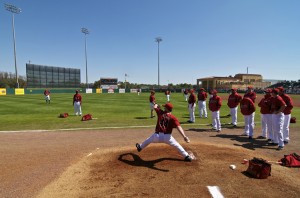Baseball’s Spring Training
February 22, 2017
Last weekend, Major League Baseball (MLB) teams began full workouts at spring training camps in Arizona and Florida. After an off-season of savoring success (for the few) or ruing defeat (for everyone else), ballplayers returned to the field to stretch, run, catch, throw, and hit in preparation for the grind of the long MLB season. As the winter chill is shaken off, the heat of competition slowly returns, and players and fans alike turn a hopeful eye toward the possibility of an October crowned by a World Series championship.

Houston Astros pitchers loosen up at their spring training facility in Kissimmee, Florida, in March 2010. The Astros opened a new spring training complex in West Palm Beach, Florida, in 2017. Credit: © John Kershner, Shutterstock
Pitchers and catchers—always the first to report—arrived at camps early last week. Pitchers need time to get their arms in shape and, well, catchers have to catch them. The Cleveland Indians, who lost the 2016 World Series by a hair’s breadth to the Chicago Cubs, were the first to arrive. On Feb. 12, 2017, the sun rose over Goodyear, Arizona, to warm bullpens suddenly blooming with the red, white, and blue of Indians’ uniforms. Within two days, pitchers and catchers from all 30 MLB teams were in their spring training homes. A few days later, position players arrived with their bats and gloves, and the full show got underway.
Baseball spring training dates back to the late 1800’s. Back then, all teams were clustered in the Midwest and northern East Coast of the United States—areas notorious for unbaseball-like weather well into spring. The Cincinnati Red Stockings (now the Reds), the first professional baseball club, first took an extended spring southern tour in 1870, spending most of their time in New Orleans, Louisiana. Over the next 30 years, many teams took advantage of southern spring warmth to prepare for the season—particularly in Arkansas and Florida—but spring training didn’t become a baseball institution until the early 1900’s.
By 1910, enough teams were training in Florida to create a competitive spring training league that became known as the Grapefruit League. Teams trained in other locations, too, such as Cuba, the Dominican Republic, and Puerto Rico—often simply as MLB marketing tours. The Cubs went out west to southern California, where they trained for years in Santa Monica and even out on Santa Catalina Island. Chewing gum magnate William Wrigley, who bought the Cubs in 1921, also owned Catalina Island. During World War II (1939-1945), fuel rationing forced teams to train close to home. During that time, for example, the New York Yankees held spring training in Asbury Park, New Jersey, and the Boston Red Sox trained at Tufts College in nearby Medford, Massachusetts.
In the desert sun of Arizona, where teams had trained from time-to-time, the spring training Cactus League firmly took root in 1947. That year, the Indians and New York (now San Francisco) Giants opened spring training facilities in Tucson and Phoenix, respectively. Other teams soon joined the Giants and Indians in the Southwest, particularly as baseball integrated and black players often met with racial discrimination in Florida.
Today, MLB teams are evenly divided between the Cactus and Grapefruit Leagues. Baseball fans flock to the warm spring training sites to take in the sun and watch their favorite teams play in the intimate settings of small ballparks and practice fields, where interaction with players is common. Well-known stars begin the games, tuning their skills at a less-than-frantic pace. The later innings provide a stage for fringe and minor league players hoping to prove themselves worthy of “heading north” with the big club for the start of the MLB regular season in April.


